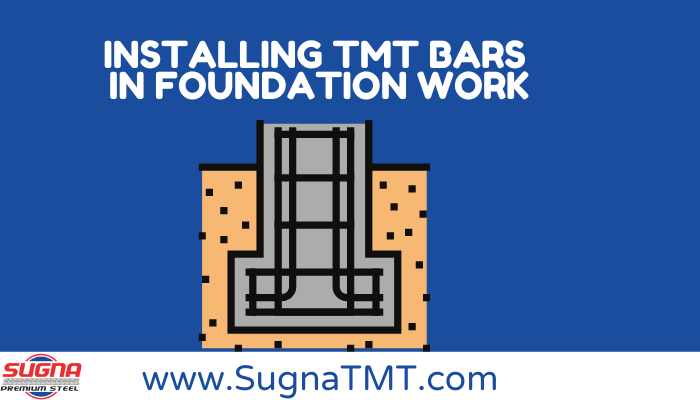The foundation is the most crucial part of any structure, as it bears the weight and transfers loads to the ground. To ensure the strength, stability, and longevity of the foundation, it’s essential to use high-quality materials and adhere to best practices during construction. Thermo-Mechanically Treated (TMT) bars, known for their superior tensile strength and flexibility, are a critical component in reinforcing concrete foundations. Proper installation of TMT bars in foundation work is vital to achieving the desired structural integrity. This blog post outlines the best practices for installing TMT bars in foundation work to ensure optimal performance and durability.

1. Correct Selection of TMT Bars
Before installation, it’s essential to select the right TMT bars for the foundation work. Consider the following factors:
- Grade of TMT Bars: Choose the appropriate grade based on the specific load requirements of the structure. Common grades include Fe 415, Fe 500, Fe 550, and Fe 600, with higher numbers indicating greater tensile strength.
- Bar Diameter: The diameter of the TMT bars should be selected according to the structural design specifications. Typically, bars ranging from 8mm to 32mm in diameter are used for foundation work.
- Corrosion Resistance: Opt for corrosion-resistant TMT bars, especially if the foundation is in a high-moisture or coastal environment. This ensures long-term durability and reduces maintenance costs.
2. Adhering to Design Specifications
Strictly follow the structural design and engineering specifications when installing TMT bars. Deviating from the design can compromise the foundation’s strength and stability. Ensure that the bar placement, spacing, and alignment match the design drawings. Key considerations include:
- Bar Spacing: Maintain the specified spacing between TMT bars to ensure even load distribution and prevent cracks in the concrete. Overlapping bars should be spaced adequately to avoid congestion.
- Bar Alignment: TMT bars must be aligned properly to ensure they function as intended. Misalignment can lead to weak points in the foundation, increasing the risk of structural failure.
3. Proper Bending and Cutting Techniques
TMT bars often need to be bent or cut to fit the design specifications of the foundation. It’s crucial to use proper bending and cutting techniques to avoid damaging the bars:
- Bending: TMT bars should be bent using a bar bending machine to achieve precise angles without compromising the bar’s strength. Manual bending can cause cracks or weaken the bars.
- Cutting: Use a mechanical cutter to cut TMT bars to the required length. Cutting with a torch or any method that generates excessive heat can alter the metallurgical properties of the bar, reducing its effectiveness.
4. Securing Bars with Binding Wire
Once the TMT bars are placed and aligned, they should be securely tied together using binding wire. This ensures that the bars remain in position during the concrete pouring process:
- Tying Technique: Use a cross or figure-eight tying technique to ensure a strong bond between intersecting bars. Avoid loose ties, as they can allow the bars to move during concrete placement.
- Adequate Spacing: Ensure that the binding wire is applied at regular intervals along the length of the bars, particularly at joints and intersections, to maintain the structural integrity of the framework.
5. Using Proper Supports and Spacers
During installation, TMT bars must be elevated from the ground and held in place using supports and spacers. This ensures that the bars are correctly positioned within the concrete:
- Supports: Use concrete or plastic supports to lift the TMT bars off the ground or formwork. This prevents direct contact with the soil, reducing the risk of corrosion and ensuring that the bars are properly embedded in the concrete.
- Spacers: Use spacers to maintain the specified cover (distance between the TMT bars and the outer surface of the concrete). Adequate cover protects the bars from environmental factors and ensures the durability of the foundation.
6. Ensuring Proper Overlap and Lapping Length
When TMT bars need to be extended, they should be overlapped according to the specified lapping length:
- Lapping Length: The lapping length should be determined based on the diameter of the TMT bars and the structural requirements. A general rule of thumb is to overlap the bars by 40 to 50 times their diameter.
- Staggering Overlaps: Avoid overlapping bars at the same point in adjacent bars, as this can create a weak spot. Stagger the overlaps to distribute the load evenly and maintain the structural integrity of the foundation.
7. Conducting Quality Checks
After installing the TMT bars, it’s essential to conduct thorough quality checks before proceeding with concrete pouring:
- Visual Inspection: Check for any signs of rust, cracks, or damage to the TMT bars. Ensure that all bars are properly aligned, spaced, and secured with binding wire.
- Testing: Perform tests such as tensile strength and bend tests on sample TMT bars to confirm they meet the required specifications. Ensure that the bars are free of any defects that could compromise the foundation’s strength.
8. Concrete Placement and Curing
The final step in foundation work involves pouring concrete over the TMT bars and allowing it to cure:
- Pouring Concrete: Pour the concrete carefully to avoid displacing the TMT bars. Use vibration techniques to eliminate air pockets and ensure that the concrete fully envelops the bars.
- Curing: Proper curing is essential to achieve the desired strength of the foundation. Keep the concrete moist for the recommended curing period to allow it to harden and bond effectively with the TMT bars.
Conclusion
Installing TMT bars correctly in foundation work is critical to ensuring the strength, stability, and durability of any structure. By following these best practices, including selecting the right TMT bars, adhering to design specifications, using proper techniques, and conducting thorough quality checks, builders can ensure that the foundation will stand the test of time. In the long run, these practices not only enhance the safety and reliability of the building but also contribute to cost savings by reducing the need for repairs and maintenance.

